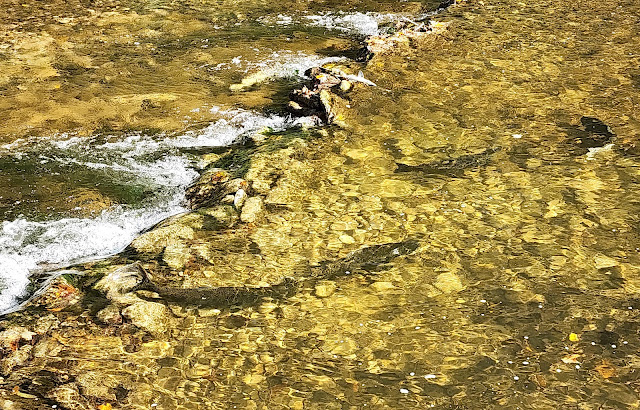After quite a few pictures from the bridge, I moved over to the side for a different view. I could watch as the fish approached that low line of rocks and with a swish of their tail, splashed up over it. In the wild and at the fish ladder I've seen salmon leap over much higher barriers.
Again I watched as groups of salmon seemed to follow one another.I was certainly getting the impression that there were a lot of migrating fish this year!
Every now and then I'd get a good look at individual fish with their rainbow of colours.
These fish will continue upstream to spawn, both in smaller spawning channels developed along the edges of the river, and in Weavers Creek, a tributary. But none of them get past Inglis Falls, a couple of kilometres to the south.
Just for interest, this is a member of the Sydenham Sportsmen Association a few years back, when I found them removing fish at the fish ladder. These fish will be the source of salmon eggs for the local hatchery.
I said I would explain a bit about the history of salmon of the Great Lakes. The original native salmon here was the Atlantic Salmon, the St. Lawrence River taking them upstream from the Atlantic to the small streams flowing into Lake Ontario to spawn. Unfortunately the building of small mill dams on every available stream to power grist and sawmills meant that the Atlantic Salmon couldn't get upstream to spawn and went extinct in the Great Lakes (Lake Ontario) by the late 1800s.
In spite of many efforts to establish salmon in the lakes from then until 1965, no amount of effort was successful. But in 1966 fisheries scientists in Michigan led the way in negotiating with their counterparts in Oregon and Washington to get salmon eggs for hatchery rearing salmon smolts. The effort was surprisingly successful, by 1970 there were self-reproducing populations of Coho and Chinook Salmon in the upper Great Lakes.
A key factor was the enormous alewife population in the Great Lakes by the mid-1960s, so high that alewife die-offs left the beaches black with their rotting bodies (I remember this!). Public attitudes strongly supported the introduction of salmon to control the alewife population, and the salmon were happy to oblige. The alewife provided a perfect food source for the salmon. In a couple of decades Great Lakes fisheries went from a value of about ten million from commercial fisheries (mainly for Lake Trout) to a value of ten billion for sport fishing (mainly for salmon).
The shift in government programs from supporting commercial fisheries to supporting sport fishing was wildly successful. The story is much more complex than this, but hopefully it gives you some perspective circa about 4 decades ago. Invasive species are the big management issue today.









Thanks for letting me know about great lakes and salmon! I keep buying (here in North Carolina) wild caught Atlantic salmon. And I am surprised because I thought there weren't any anymore, except farmed. Need to do some research I guess.
ReplyDeleteI had to google alewife because I never heard of them. Every day’s a school day as we are constantly told. I’m not surprised Mrs FG makes you eat healthily. Step daughter is always trying that nonsense with us. Unfortunately spinach makes me ill and the Chef hates it so she’s not having much success.
ReplyDeleteThat is interesting and I'm glad they were successful with the introduction of the salmon. Though, I'll admit that it makes me a wee bit sad to know that the end of the trip upstream means death to the fish.
ReplyDeleteI learned something new (to me) too, as I had not heard of alewife either. :)
I have never heard aabout the salmon in the Great Lakes. It is great info and all new tome. You got tosee them traveling up stream. Great.
ReplyDelete